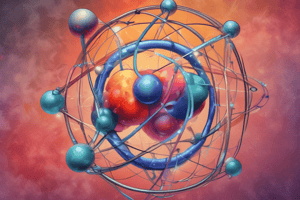Podcast
Questions and Answers
What makes metallic compounds strong?
What makes metallic compounds strong?
- The low melting points and malleability of metals
- The sea of electrons that hold the atoms together (correct)
- The arrangement of atoms in a cubic structure
- The presence of ionic bonds between metal atoms
How do the size of metal atoms affect the strength of metallic bonds?
How do the size of metal atoms affect the strength of metallic bonds?
- Larger atoms create stronger bonds due to increased size
- Size does not affect the strength of metallic bonds
- Smaller atoms can pack together more tightly, leading to stronger bonds (correct)
- Only the shape of the atom influences bond strength
Which of the following properties is not characteristic of metals?
Which of the following properties is not characteristic of metals?
- Low thermal conductivity (correct)
- High melting points
- High electrical conductivity
- Malleable and ductile
What role do valence electrons play in metallic bonding?
What role do valence electrons play in metallic bonding?
Which bond forms first in a double bond?
Which bond forms first in a double bond?
Why are metals considered ductile and malleable?
Why are metals considered ductile and malleable?
What is the primary reason for metals having high melting points?
What is the primary reason for metals having high melting points?
What is the relationship between bond strength and bond length?
What is the relationship between bond strength and bond length?
What distinguishes a pi bond from a sigma bond?
What distinguishes a pi bond from a sigma bond?
Which of the following correctly describes a characteristic of weaker bonds?
Which of the following correctly describes a characteristic of weaker bonds?
What prefix is used to indicate one atom of the first element in a binary molecular compound?
What prefix is used to indicate one atom of the first element in a binary molecular compound?
What is the correct naming convention for the acid formed from hydrochloric acid?
What is the correct naming convention for the acid formed from hydrochloric acid?
Which polyatomic ion, when forming an oxyacid, results in an acid that ends with -ous?
Which polyatomic ion, when forming an oxyacid, results in an acid that ends with -ous?
Which of the following is an example of a molecule that forms with an incomplete octet?
Which of the following is an example of a molecule that forms with an incomplete octet?
In which scenario can an element's octet be expanded beyond eight electrons?
In which scenario can an element's octet be expanded beyond eight electrons?
What does a free radical represent in molecular terms?
What does a free radical represent in molecular terms?
What property of ionic compounds is primarily due to the strong bonds between ions?
What property of ionic compounds is primarily due to the strong bonds between ions?
Which statement correctly describes how ionic compounds conduct electricity?
Which statement correctly describes how ionic compounds conduct electricity?
When writing the formula for binary ionic compounds, what must be ensured?
When writing the formula for binary ionic compounds, what must be ensured?
What is the correct nomenclature for the compound FeCl₃?
What is the correct nomenclature for the compound FeCl₃?
Which polyatomic ion example is correctly paired with its formula?
Which polyatomic ion example is correctly paired with its formula?
In the construction of polyatomic compounds, what is the primary concern regarding charges?
In the construction of polyatomic compounds, what is the primary concern regarding charges?
Which of the following describes the structure of metallic compounds?
Which of the following describes the structure of metallic compounds?
Which property of metals is a direct result of their unique bonding and structure?
Which property of metals is a direct result of their unique bonding and structure?
Flashcards
Metallic Bond Strength
Metallic Bond Strength
The strength of the bond between metal atoms in a metallic compound, determined by the number of valence electrons and the size of the metal atoms.
Metallic Lattice Structure
Metallic Lattice Structure
A regular, repeating pattern of metal atoms arranged in a lattice, which allows for flexibility and ductility in metals.
Sea of Electrons
Sea of Electrons
A cloud of delocalized valence electrons that are free to move within the lattice structure of a metal, forming strong, flexible bonds.
Metallic Properties (Conductivity)
Metallic Properties (Conductivity)
Signup and view all the flashcards
Metallic Properties (Ductility/Malleability)
Metallic Properties (Ductility/Malleability)
Signup and view all the flashcards
Covalent Bond (Sigma)
Covalent Bond (Sigma)
Signup and view all the flashcards
Covalent Bond (Pi)
Covalent Bond (Pi)
Signup and view all the flashcards
Covalent Bond (Strength/Length/Energy)
Covalent Bond (Strength/Length/Energy)
Signup and view all the flashcards
Ionic Compound Properties
Ionic Compound Properties
Signup and view all the flashcards
Metallic Bond
Metallic Bond
Signup and view all the flashcards
Metallic Structure
Metallic Structure
Signup and view all the flashcards
Metallic Properties
Metallic Properties
Signup and view all the flashcards
Binary Compound Formula
Binary Compound Formula
Signup and view all the flashcards
Polyatomic Ion
Polyatomic Ion
Signup and view all the flashcards
Oxidation State
Oxidation State
Signup and view all the flashcards
Balancing Charges (Ionic Compounds)
Balancing Charges (Ionic Compounds)
Signup and view all the flashcards
Bond Length and Dissociation Energy
Bond Length and Dissociation Energy
Signup and view all the flashcards
Binary Molecular Compound Naming
Binary Molecular Compound Naming
Signup and view all the flashcards
Binary Acid Naming
Binary Acid Naming
Signup and view all the flashcards
Oxyacid Naming
Oxyacid Naming
Signup and view all the flashcards
Incomplete Octet
Incomplete Octet
Signup and view all the flashcards
Expanded Octet
Expanded Octet
Signup and view all the flashcards
Odd Number of Electrons
Odd Number of Electrons
Signup and view all the flashcards
Octet Rule Exceptions
Octet Rule Exceptions
Signup and view all the flashcards
Study Notes
Atomic Radius
- Decreases across a period (→): More protons pull electrons closer to the nucleus.
- Increases down a group (↓): More electron shells are added, increasing size.
Ionic Radius
- Cations (positive ions): Smaller than their parent atoms. Losing electrons reduces electron-electron repulsion.
- Anions (negative ions): Larger than their parent atoms. Gaining electrons increases repulsion, expanding the ion.
- Decreases across a period (→) for ions of the same charge: Higher nuclear charge pulls electrons closer.
- Increases down a group (↓): More electron shells increase size.
Ionization Energy (IE)
- Increases across a period (→): Electrons are held more tightly due to higher nuclear charge.
- Decreases down a group (↓): Electrons are farther from the nucleus and easier to remove.
Electronegativity
- Increases across a period (→) Atoms want to complete their octet (non-metals attract electrons strongly).
- Decreases down a group (↓): Larger atoms have weaker attraction for bonding electrons.
Quantum Numbers
- The energy level or shell of an electron. How far the electron is from the nucleus
- Each energy level (n) can hold 2n² electrons.
- Energy level (n): Subshells: Number of orbitals: Max electrons.
- n=1: s: 1: 2
- n=2: s,p: 1+3=4: 8
- n=3: s,p,d: 1+3+5=9: 18
- n=4: s,p,d,f: 1+3+5+7=16: 32
Studying That Suits You
Use AI to generate personalized quizzes and flashcards to suit your learning preferences.




